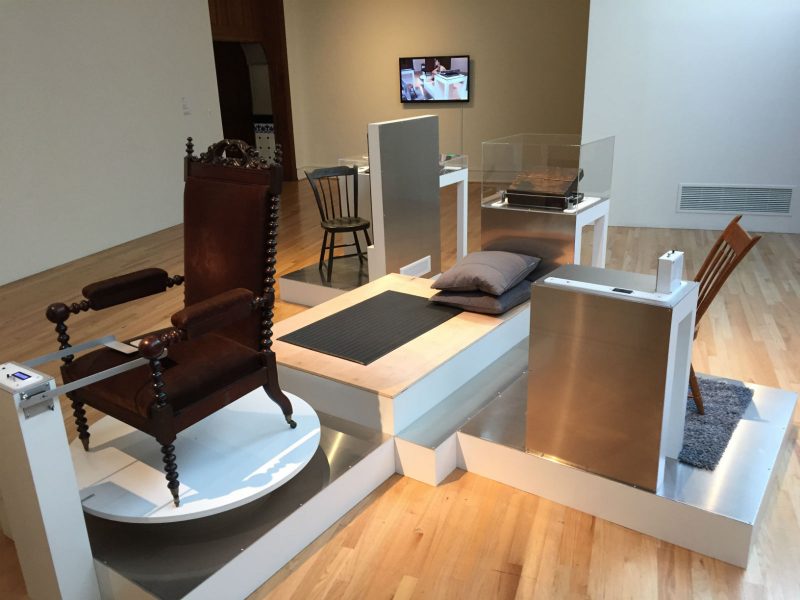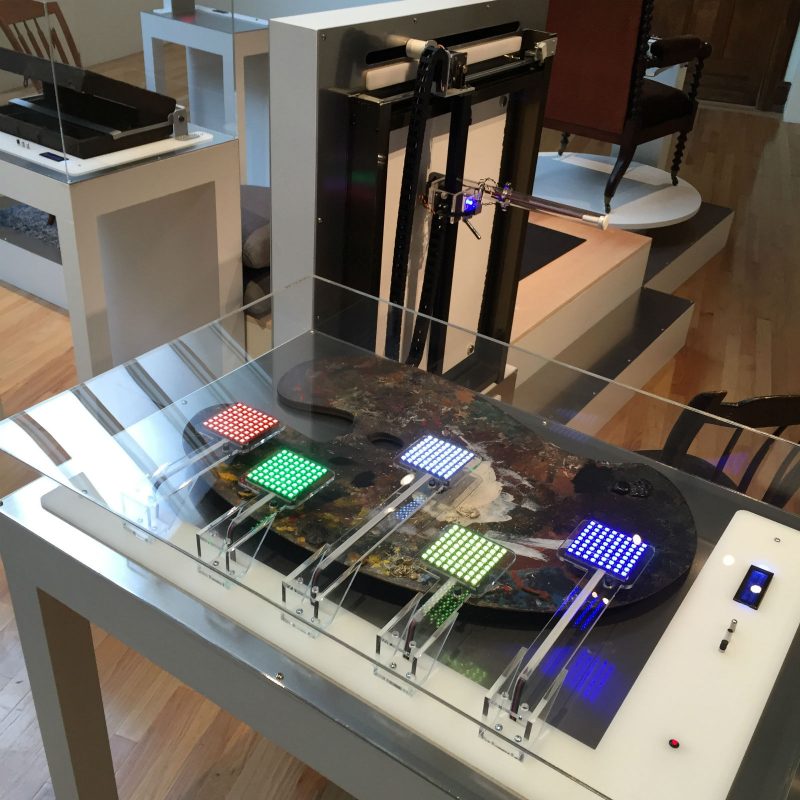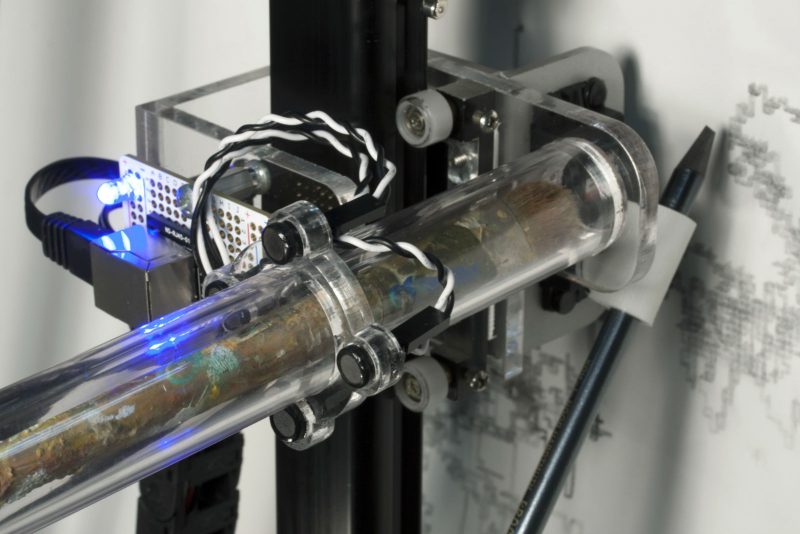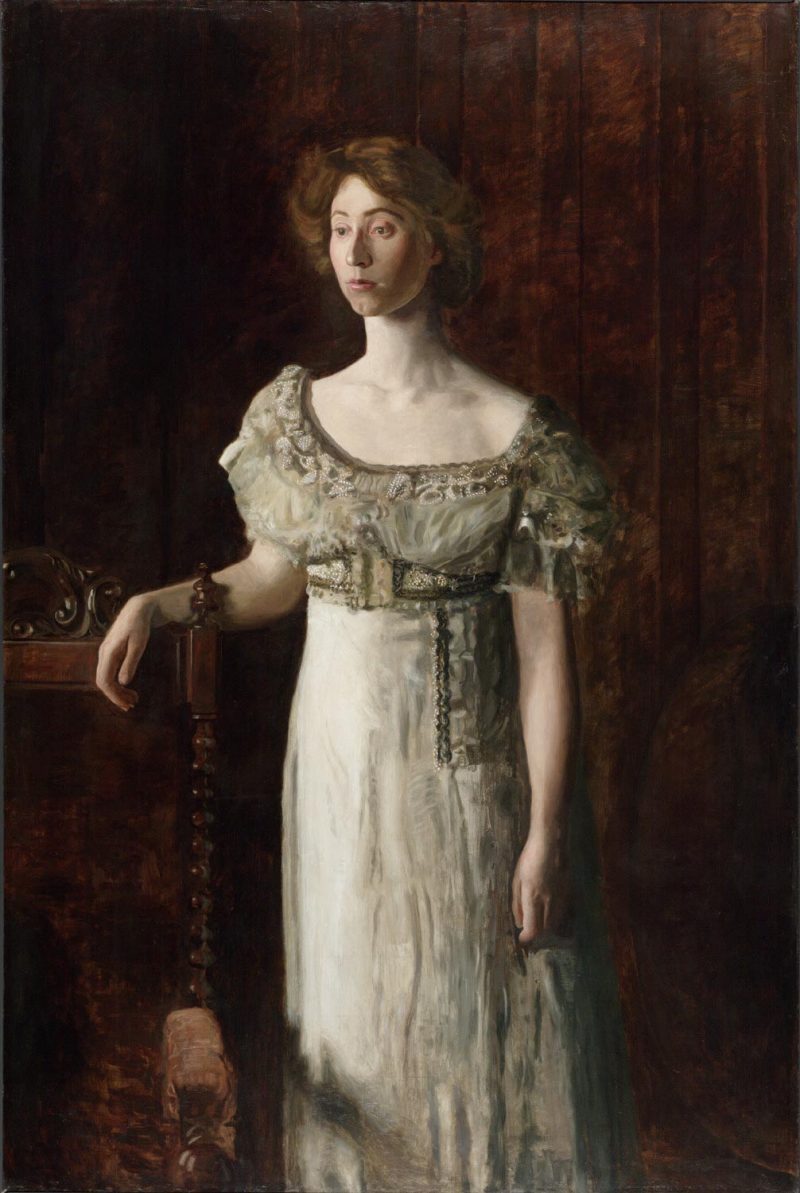The presence of famed Philadelphia painter Thomas Eakins (d. 1916) has long been felt at PAFA, but Fernando Orellana’s new installation, His Study of Life, aims to evoke Eakins’ spirit in a very direct way–via machines attached to objects used by the painter that seek to register his ghostly presence, measured in terms of fluctuations in electromagnetic fields, temperature, and infrared light. These are not the first so-called ghost machines that Orellana has made, but this is the first time he has attached his machines to both historic objects and a historic setting. The juxtaposition of old and new produces a resonance between past and present that activates the space of the Morris Gallery, a former studio in PAFA’s historic Furness building, opened in 1876. Orellana and Curator of Contemporary Art Jodi Throckmorton confront some of PAFA’s ghosts, putting together a thought-provoking installation that offers a new perspective on the life, art, and legacy of Thomas Eakins.

Orellana’s installation consists of four machines constructed to interact with a paint box, palette, and paintbrush from Eakins’ studio, and a large armchair from his home. Each of these objects, taken from PAFA’s archives, are attached to machines designed and engineered by Orellana. Together, the paint box, palette, and paintbrush reminded me of the relics of saints–the remains of holy men and women, or the objects, earth, or clothing that came in contact with them during their lives. Too precious for human hands to touch, too powerful to stay buried in the ground (or archive), they can only be accessed through the containers that surround them. The saint’s (or artist’s) power is manifested by his ability to produce miracles through his relics. With His Study of Life, Orellana offers us the possibility of a sort of post-modern miracle, making a tongue-in-cheek yet deeply serious exploration of the religion of art, and of the ghost in the machine.
Flesh, paint, and the machine

In the center of this still life ensemble is a space devoted to a nude model, who poses for twenty minutes at a time in postures taken from Eakins’ drawings and photographs. The juxtaposition of the single, silent model with the occasional whirs of Orellana’s ultra-modern, almost clinical machines was unsettling. I felt what some of Eakins’ students might have felt while he taught at PAFA–as though I was transgressing some invisible boundary of propriety or even morality, becoming a voyeur as much of the spirits of the dead as the bodies of the living. Eakins was infamous for his insistence on his male and female students studying male as well as female nude models–both living and dead. His unconventional attitude to the unclothed male human form resulted in his dismissal from the faculty at PAFA in 1886, but his legacy as a painter and a teacher continues to dominate the institution.

Eakins’ tools evoke the hand and personality of the painter, in sharp contrast to the cold, impersonal machines that surround them. His wooden paint box, its lid decorated with a marvellously assertive “E.,” is encased in a machine that opens and closes in response to ghostly presence. Next to the paint box, five small square clusters of lights hover over Eakins’ palette, still heavily encrusted with daubs of paint. Red, green, yellow, and blue squares of lights line the outer edge, while a white square is located towards the center of the palette. The machine must have sensed something (or been acting up) while I was visiting, because the lights in the central white square flickered various colors, as though ghostly hands were mixing paint in some alternate dimension. There is something mesmerizing about watching the little flickering lights, which almost seem to touch the surface of the palette like palpating fingers.

The last of Eakins’ instruments, a paintbrush, has been hermetically sealed in a clear cylinder right next to a pencil hooked up to a ghost machine, which sporadically makes indecipherable marks on a sheet of paper. In addition to this Surrealist-Spiritualist automatic drawing, the machine has been programmed to sketch a series of five figure studies, samples of which have been pinned on the wall near the gallery’s entrance.
Lingering spirits

Finally, there is the wooden armchair with its dark velvet upholstery, poised on what amounts to a large lazy susan that rotates when it detects a ghostly presence. The chair looks like a relic of the Victorian past, its dark, heavy solidity contrasting with the sleek lines and clinical whites of Orellana’s machines. This very chair was often used by Eakins in his drawings, paintings, and photographs, including a work that hangs upstairs in PAFA’s galleries–Eakins’ 1908 painting, “The Old Fashioned Dress.” I stumbled across this painting unexpectedly while exploring the permanent collection. Seeing the painted chair, I felt like I had seen a ghost, an uncanny experience that momentarily shifted my sense of reality slightly to some unidentifiable place between virtual representation and physical presence. Ultimately, Orellana seems to suggest, Eakins’ spirit may not reveal itself in the activation ghost machines, but rather in the interaction between living viewers and the works of art he left behind.
Fernando Orellana: His Study of Life is on view in the Morris Gallery of the Historic Landmark Building at PAFA, 118 Broad St., Philadelphia, PA, 19102. Open Tuesday, Thursday, and Friday 10–5 pm, Wednesday 10–9 pm, and Saturday and Sunday 11–5 pm. The opening reception will take place on September 7, 6–8 pm.









